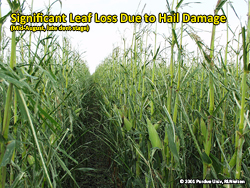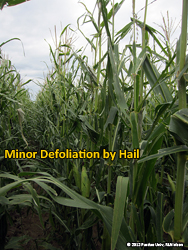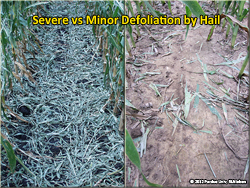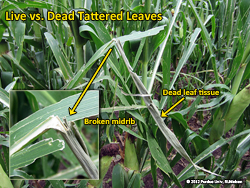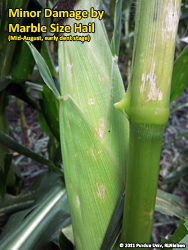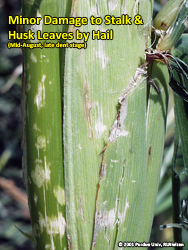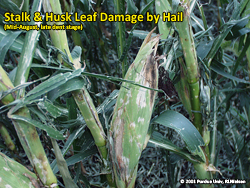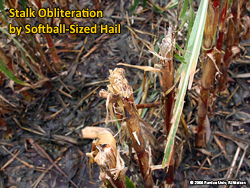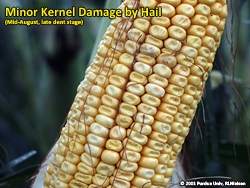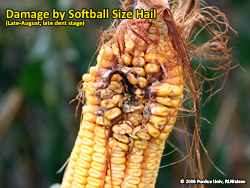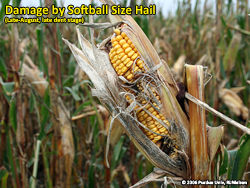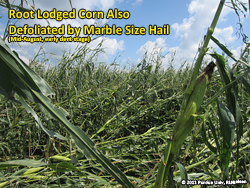August 2012
URL: http://www.kingcorn.org/news/timeless/HailDamageLateSeason.html
Late-Season Hail Damage to Corn
R.L. (Bob) Nielsen
Agronomy Dept., Purdue Univ.
West Lafayette, IN 47907-2054
Email address: rnielsen
at purdue.edu
![]() ate-season hail storms can defoliate corn plants, shred leaves, bruise or damage stalks, and bruise or damage ears in fields unfortunate enough to be in their paths. Yield loss from such late season hail damage is due primarily to the defoliation, but the extent of the defoliation can be tricky to quantify. Additional loss of yield or reduction in grain quality can occur from physical damage to the kernels on the ears. Stalk breakage or lodging can interfere with harvest of the damaged fields and result in mechanical harvest losses.
ate-season hail storms can defoliate corn plants, shred leaves, bruise or damage stalks, and bruise or damage ears in fields unfortunate enough to be in their paths. Yield loss from such late season hail damage is due primarily to the defoliation, but the extent of the defoliation can be tricky to quantify. Additional loss of yield or reduction in grain quality can occur from physical damage to the kernels on the ears. Stalk breakage or lodging can interfere with harvest of the damaged fields and result in mechanical harvest losses.
Hail damage to leaves typically looks worse than it really is, because most of us tend to assume tattered leaves will no longer function. This assumption is correct if the tattered leaves eventually dry up and wither away. However, if the tattered leaves don’t actually die, they still contribute to the continued functioning of the photosynthetic factory.
As with hail damage that occurs earlier in the season, the first step in assessing the severity of hail damage to corn is to take a deep breath and keep busy with other things for several days before walking the damaged field. This first step serves two functions. One is to allow yourself some time to calm down. More importantly, the several day wait period will better identify whether shredded, tattered leaves will die or remain green and functional.
Yield loss to defoliation is dependent on the growth stage of the crop. The greatest potential yield loss due to defoliation exists at the critical pollination period and becomes increasingly less the closer the crop gets to grain maturation (kernel black layer). Corn loss tables published by National Crop Insurance Services that list expected yield loss to defoliation at varying growth stages are reproduced in our ID-179 Corn and Soybean Field Guide if you have a copy of that publication or in the Klein & Shapiro (2011) publication from the Univ. of Nebraska.
Minor bruising of the stalk or ear husks will be of little consequence and should not result in any appreciable risk of stalk or ear rot development. Where hailstones are large or intense enough to actually gouge into the stalk, then the physical structural integrity of the stalk is compromised and standability may become an issue before harvest.
Hailstorms that also pack quite a bit of wind can cause significant stalk breakage and lodging, especially where the corn rows are oriented perpendicular to the direction of the wind. In fields where root depth or strength is compromised by other stresses, the driving impact of a severe hail storm may literally uproot plants.
A minor bit of good news with late-season hail damage is that significant defoliation in hail-damaged fields may actually contribute to faster grain drydown because of greater wind movement through the damaged crop canopy. Grain maturation timing may be hastened a bit, also.
Related reading
Corn & Soybean Field Guide. 2012. Purdue Univ. Available to order at http://www3.ag.purdue.edu/agry/dtc/Pages/field-guide.aspx [URL accessed Aug 2012].
Klein, Robert and Charles Shapiro. 2011. Evaluating Hail Damage to Corn. Univ of Nebraska Extension Pub. EC-126. http://www.ianrpubs.unl.edu/live/ec126/build/ec126.pdf [URL accessed Aug 2012].
Lauer, Joe. 2009. Late-season hail effects on corn. Agronomy Advice, Univ of Wisconsin. http://corn.agronomy.wisc.edu/AA/pdfs/A069.pdf [URL accessed Aug 2012].

